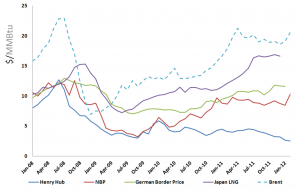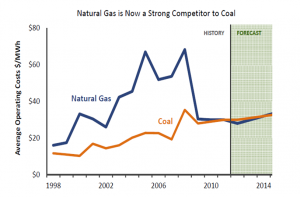Nuclear Power – The Dream lives on!
Now it is clear that at $2 / million BTU, new build nuclear is not competitive. Not a big surprise. However it does need to be put in context and the time has come to make a few key points about the economic competitiveness of nuclear power on a global scale, not just in North America. This is especially important following the article in the Economist on the first anniversary of the Fukushima accident. With a cover that read “Nuclear Energy – The Dream that Failed”, the Economist provided an analysis that was strong on data, but weak on insight resulting in understandable but still (in my view) wrong conclusions.
First let’s talk about gas prices. Yes, gas prices are at a historical low in North America. But this is the exception, not the rule globally. In most markets as can be seen in the figure below, gas prices follow oil prices with Europe (UK’s National Balance Point – NBP and German Border Price) and Asia experiencing gas prices 3 to 5 times those in North America (Henry Hub). It is easy to see the issue Japan is facing where LNG and Oil (Brent) are high so that nuclear power remains very competitive and as such is a needed source of supply to prevent electrical utilities from going bankrupt.
Fuel Prices ($/million BTU)
Source: Didier Houssin “International Energy Outlook” presented at the World Nuclear Fuel Conference, Helsinki April 2012
Second, the Energy Information Administration (EIA) in their 2012 Annual Energy Outlook Early Release continue to project gas prices below $5 million BTU for America until 2024 and thereafter rising to about $6.52 million BTU by 2035. While this is below the $7.78 million BTU used by the International Energy Agency (IEA) in its “Project Cost of Electricity Generation 2010” that shows nuclear being competitive in the US, prices in the mid to high $6 range are sufficient for nuclear to be competitive. (Note: nuclear was about 15% less costly than gas in the IEA report). And since most new plants will come in to service in the post 2023 time period, there is every likelihood that nuclear can be competitive in the US with gas in this crucial time period.
And finally, while the resource estimate for gas in the US continues to increase, there is rarely a discussion of price. Yet resources are related to price. The higher the price the more resource is exploitable and the lower the price, the less resource will come out of the ground. With gas there is a bit of unique situation where the price has become decoupled from oil in the US and so for conventional gas, drilling will continue coincident with high oil prices. However will we see much drilling for new shale gas at these low prices? One thing the oil and gas industry knows how to do is make money and they are quick to walk away from projects that do not make economic sense.
In the short term, low gas prices in the US will likely reduce green house gas emissions as gas is used to replace coal. At current prices, gas has become competitive with coal and emits about half the carbon when compared to coal. But in the medium to long term, nuclear remains the only very low (essentially zero) carbon option for reliable base-load generation.
Source: TVA President’s Report to the Board February 2012
Going back to the article in the Economist let’s put some context on their conclusions related to nuclear competitiveness.
Economist: In liberalised energy markets, building nuclear power plants is no longer a commercially feasible option: they are simply too expensive.
What we think: New build nuclear has never been built into liberalized energy markets. The reasons are somewhat complex and go beyond the discussion in this blog post. The issues are more related to the fact that open markets work best with projects that can be built quickly with low capital costs. And most markets have been designed with gas in mind. Gas prices set the market price so the risk for gas plants is very low. On the other hand, even when their energy cost are very competitive, nuclear plants have relatively high capital costs and long project schedules requiring predictable electricity prices into the future. So this is nothing new although the UK will be the first to build such plants by modifying the market to try and accommodate the issues related to nuclear. On the other hand, nuclear plants, once in operation, operate very successfully in liberalized markets due to their very low production costs.
Economist: Existing reactors can be run very profitably; their capacity can be upgraded and their lives extended.
What we think: Very true
Economist: But forecast reductions in the capital costs of new reactors in America and Europe have failed to materialise and construction periods have lengthened.
What we think: While the first new units in America and Europe have had challenges resulting in not meeting budgets or schedules, we cannot forget that in Asia where there are many plants under construction, the benefits of standardization and series construction have been and continue to be proven. With a small number of plants being built in the western world, now is the time to ensure that lessons learned in Asia are transferred to the west so that the same benefits are achieved.
Economist: Nobody will now build one without some form of subsidy to finance it or a promise of a favourable deal for selling the electricity.
What we think: The context of this statement is incorrect. Modern liberalized electricity markets work well for gas and sometimes coal, but for nothing else. Large complex projects such as nuclear and large hydro are not amenable to the current market structures. The Economist does not mention that all wind and solar are heavily subsidized by governments around the world as they are not in any way currently economically competitive. Yet somehow this is acceptable. On the other hand, in most jurisdictions, nuclear is indeed competitive, but needs stability of electricity price to enable the large up front capital investment. So the issue in most cases is not requiring subsidy per se, but rather stability. Yes, in the US the first movers are offered some support to help overcome first of kind issues related to not building in over 30 years. But in the medium to long term, this support is expected to fall away whereas renewable support is expected to remain required for the foreseeable future.
Economist: And at the same time as the cost of new nuclear plants has become prohibitive in much of the world
What we think: As discussed above exactly the opposite is true. In most parts of the world where nuclear is being built it is very competitive. Higher gas prices and lower nuclear costs result in very economic new build plants in China and elsewhere. The experience in Europe and the US is primarily due to building after a very long hiatus and now it is up to the industry to demonstrate that the price can come down in line with other markets.
Economist: Nuclear is getting more expensive whereas renewables are getting cheaper
What we think: Again, in China, Korea, India and other locations nuclear is indeed coming down in price with series new build of standardized designs. As I discussed in my previous posting, the cost in the west is increasing due to the lack of new projects resulting in a lack of confidence. Each bad experience causes estimates to go up while in the east each new project results in lower costs than the preceding project. This is why the Asians are now becoming nuclear exporters.
Economist: Nuclear power will continue to be a creature of politics not economics, with any growth a function of political will or a side-effect of protecting electrical utilities from open competition. This will limit the overall size of the industry.
What we think: Nuclear power will always be a creature of politics. However for success, it must also be economic. In most jurisdictions there will be very little political will to move forward with new nuclear and all of its associated issues unless the project can be shown to be economically attractive. China is building in large quantities because they need large scale base-load electricity and nuclear is very competitive with the alternatives. The same goes for Korea and other markets.
In summary, nuclear is not a dream that failed, but rather is one of the most extraordinary discoveries of the 21st century that can still realize its potential for supplying global electricity for millennia. The Asians see the benefits and are moving forward with nuclear power to meet their ever growing energy needs. The question is will the western world wake up and learn from this eastern success.
For fully global success, new build nuclear must demonstrate that it is competitive in an economic sense. The current state of gas prices and other issues will continue to present challenges to nuclear power but these can all be overcome in the longer term as standardization and series construction continues to demonstrate that it is the most economic, reliable and safe method of electricity generation. The nuclear dream lives on.






